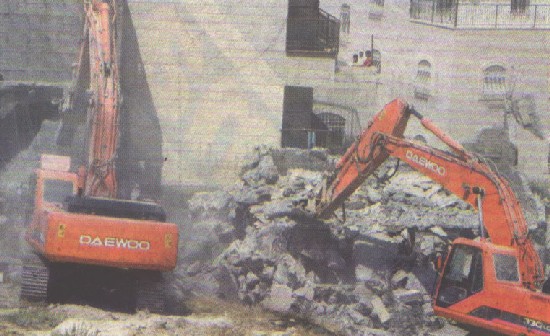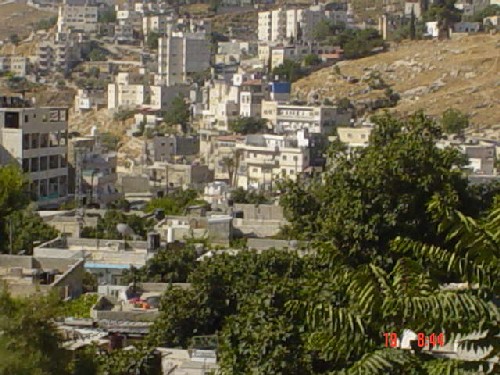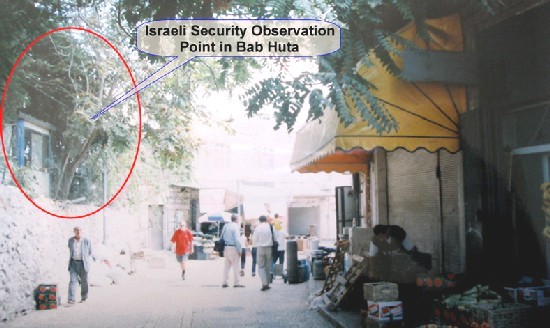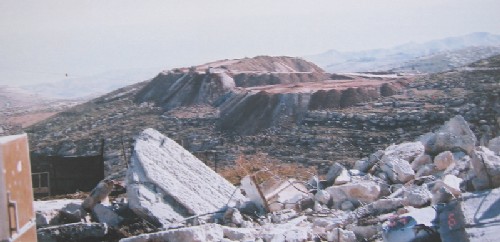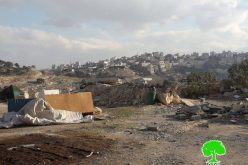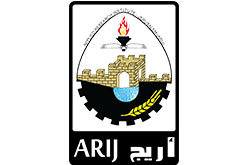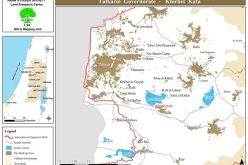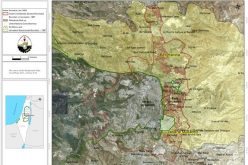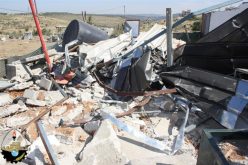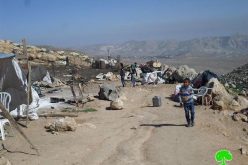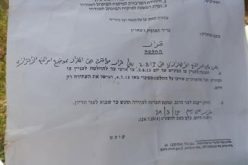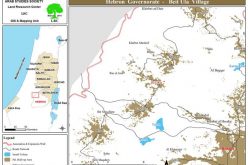Israeli demolition of Palestinian houses in Jerusalem continued unabated during 2005
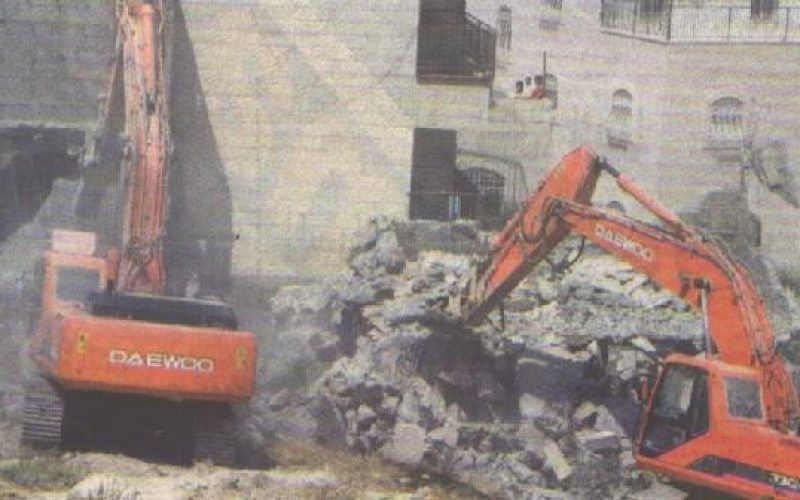
Photo courtesy of Al-Quds newspaper (June 15, 2005)
Introduction
The Israeli occupation authorities continued their hostile policies in Jerusalem during the year 2005. In this regard, the Israeli municipality of occupied Jerusalem, in collaboration with the ministry of interior and its security apparatuses waged a fierce war against the Palestinian presence in Jerusalem leading to the demolition of dozens of houses and homelessness of hundreds of Palestinian men, women and children.
In the meanwhile, the Israeli authorities went on building the Annexation and Separation Wall around the city splitting apart Palestinian residential areas and cutting off Jerusalem from its immediate Palestinian environs and from the rest of the West Bank. At the same time, the Wall is aimed at annexing into Israel all the Jewish colonies which were illegally built around Jerusalem inside the West Bank territory.
The aforementioned measures were accompanied by a series of serious acts, such as:
1. The announcement of the new Master Plan for the years 2000-2020 which aims at crossing out the city as an Arab Islamic and Christian city to guarantee the impossibility of making it a future Palestinian capital;
2. The reactivation of the absentee property law to serve the interests of the occupation authorities;
3. The reactivation of the Planning and reconstruction law number 512/5 for the year 1965 for the benefit of the occupation;
4. The commencement of land registration ̢?? tabooing Рin the names of Israeli colonists living in the old city or in the colonies of Bisgat Ze'ev and Har Homa which, once again, proves the real Israeli intensions of Judaizing the whole city.
Facts and figures
Last year, The Land Research Center (LRC) documented the following house demolitions and violations in Jerusalem:
-
First: 120 housing units were destroyed with a total surface area of 13457 square meters and a total of 424 rooms. As a result, 481 Palestinians, including 249 children under the age of 18 were made homeless.
-
Second: Dozens of other structures such as commercial stores, cisterns, retaining walls, farms â?¦etc were also destroyed.
-
Third: Millions of New Israeli Shekels were imposed as fines on Palestinian citizens of Jerusalem under the pretexts of violating building and construction laws.
Table No. (1): House demolition in Jerusalem under the pretext of un- licensing by name of owner, date of demolition, location, area, number of housing units and number of family members and children
|
No. |
Owner name |
Dem. date |
Location |
Area M2 |
Family Members |
Notes |
|
|
|
|
|
|
|
|
|
1 |
Saleh Wahdana Al Barguth |
17.1.05 |
Al Juzweiza- Al walaja |
84 |
|
|
|
2 |
Salim Ali Abu Riziq |
17.1.05 |
Al Juzweiza- Al walaja |
84 |
|
|
|
3 |
Fatimah Shehada Khalifa |
17.1.05 |
Al Juzweiza- Al walaja |
84 |
|
|
|
4 |
Sameer Jubran Wahdana |
17.1.05 |
Al Juzweiza- Al walaja |
84 |
|
|
|
5 |
Fakhri Abdullah Khalifa |
17.1.05 |
Al Juzweiza- Al walaja |
84 |
|
|
|
6 |
Imad Hasan Abu Teen |
17.1.05 |
Al Juzweiza- Al walaja |
84 |
|
|
|
7 |
Ahmad Mohammed Al Qadi |
25.1.06 |
Old city |
44 |
|
|
|
8 |
Mohammed Ahamd Jabarin |
28.1.06 |
Ashqariya- Beit Hanina |
24 |
7 |
Demolished by owner himself under Israeli threats |
|
|
Total 1 |
|
|
572 |
7 |
|
|
9 |
Imam Mohammed Ash Shuweiki |
14.2.05 |
Ashqariya- Beit Hanina |
150 |
7 |
Another housing unit was destroyed on 5.6.03 |
|
10 |
Isam Mustafa Harhash |
22.2.05 |
Ashaiyah-Mt. olives |
1400 |
8 |
Stores and garages |
|
11 |
Mohammed Jamil Al Atrash |
23.2.05 |
Sur Baher |
180 |
9 |
|
|
12 |
Fa'iq Nasif Habash |
28.2.05 |
Old city |
14 |
8 |
|
|
|
Total 2 |
|
|
1744 |
32 |
|
|
13 |
Zahira Khalil Mutawi' |
10.3.05 |
Asheik Anbar-Mt. olives |
160 |
10 |
|
|
14 |
Subhi At Turi |
14.3.05 |
Kafr Aqab- Samiramis |
400 |
|
|
|
15 |
Lutif Ahamd Atallah |
22.3.05 |
Wadi Hilwa- Silwan |
100 |
9 |
Second floor |
|
16 |
Aisha Ibrahim Sirahn |
22.3.05 |
Al Bustan â?? Silwan |
240 |
7 |
Under construction |
|
17 |
Yusif Ayub Shuqeir |
21.3.05 |
Bashir Quarter- Al Mukaber |
60 |
3 |
Made of cement & bricks |
|
|
Total 3 |
|
|
960 |
29 |
|
|
18 |
Mohammed Ali Jaber |
4.4.05 |
Beit Hanina |
600 |
9 |
|
|
19 |
Isam Ibrahim Abu Eid |
4.4.05 |
Bit Hanina |
250 |
5 |
|
|
20 |
Saif Yaser Tantash |
4.4.05 |
250 |
250 |
3 |
|
|
21 |
Taghrid Shebana Sanduqa |
4.4.05 |
Beit Hanina |
50 |
4 |
Demolished for the second time |
|
22 |
Tahani Abdulsalam At Tabel |
4.4.05 |
Beit Hanina |
120 |
7 |
|
|
23 |
Mar'i Mohammed Ka'abnah |
6.4.05 |
Beit Hanina |
130 |
7 |
Demolished for Wall construction- animal shed |
|
24 |
Yusif Mohammed Ka'abnah |
6.4.05 |
Beit Hanina |
130 |
7 |
Demolished for Wall construction- animal shed |
|
25 |
Musa Mohammed Ka'abnah |
6.4.05 |
Beit Hanina |
130 |
1 |
Demolished for Wall construction- animal shed |
|
26 |
Yunis Mohammed Ka'abnah |
6.4.05 |
Beit Hanina |
130 |
|
Demolished for Wall construction- animal shed |
|
27 |
Faisal Hasan Imlihat |
6.4.05 |
Beit Hanina |
90 |
5 |
Demolished for Wall construction- animal shed |
|
28 |
Yusif Hasan Imlihat |
6.4.05 |
Beit Hanina |
90 |
4 |
Demolished for Wall construction- animal shed |
|
29 |
Zir'i Musa Za'atrah |
6.4.05 |
Izariya ( Bethany) |
160 |
12 |
|
|
30 |
Saleh Zir'i Ali |
6.4.05 |
Ras Isbitan- Mt. Olives |
160 |
2 |
Demolished for Wall construction |
|
31 |
Ali Zir'i Ali |
6.4.05 |
Ras Isbitan- Mt. Olives |
160 |
4 |
Demolished for Wall construction |
|
32 |
Ibrahim Zir'i Ali |
6.4.05 |
Ras Isbitan- Mt. Olives |
160 |
3 |
Demolished for Wall construction |
|
33 |
Hisham Rajab At Tamimi |
13.4.05 |
Anata |
120 |
11 |
|
|
34 |
Ahamd Omer Al Haliya |
13.,4.05 |
Anata |
160 |
18 |
|
|
35 |
Basem Ramadan Ajlouni |
13.4.05 |
Kafr Aqab |
115 |
4 |
|
|
|
Total 4 |
|
|
3005 |
106 |
|
|
36 |
Samer Mahmud Siam |
1.5.05 |
Silwan |
40 |
4 |
|
|
37 |
Rami Mohammed Dabash |
2.5.05 |
Sur Baher |
150 |
4 |
|
|
38 |
Aref Hussein Bashir |
2.5.05 |
Jabel Al Mukaber |
150 |
8 |
Under construction |
|
|
Total 5 |
|
|
340 |
16 |
|
|
39 |
Amer Hisham Harhash |
15.6.05 |
Atur ( Mt. olives) |
1700 |
30 |
Two floor house and Garages |
|
40 |
Hisham Mohammed Abu Gharbiya |
15.6.05 |
Athuri quarter |
400 |
10 |
|
|
41 |
Atwan Mohammed Zahran |
24.6.05 |
Beit Hanina |
60 |
9 |
|
|
|
Total 6 |
|
|
2160 |
49 |
|
|
42 |
Saleh Mohammed Isawi |
4.7.05 |
Isawiya |
100 |
8 |
|
|
43 |
Miriyam Ahmad Jaradat |
5.7.05 |
Beit Hanina |
70 |
8 |
|
|
44 |
Shehda Ahamd Jabarin |
5.7.05 |
Beit Hanina |
130 |
3 |
|
|
45 |
Fawzi Radwan Abu Isneina |
5.7.05 |
Mt. olives |
230 |
7 |
|
|
46 |
Abdullah Taleb Khader |
7.7.05 |
Beit Hanina |
120 |
16 |
|
|
47 |
Ni'ma Yusif Abu Miala |
7.7.05 |
Beit Hanina |
120 |
5 |
|
|
48 |
Musa Hasan Al Mandub |
12.7.05 |
Silwan |
130 |
10 |
|
|
49 |
Mustafa Tawfiq Hanafiya |
12.7.05 |
Isawiya |
100 |
7 |
|
|
50 |
Mustafa Hasan Siam |
12.7.05 |
Silwan |
130 |
10 |
|
|
51 |
Atef Mohammed Abu Duweih |
26.7.05 |
Al Mukaber |
160 |
7 |
|
|
52 |
Fayez Hussein 'Ibidat |
26.7.05 |
Al Mukaber |
125 |
6 |
|
|
53 |
Muneer Hussein Ibidat |
26.7.05 |
Al Mukaber |
125 |
7 |
|
|
|
Total 7 |
|
|
1540 |
94 |
|
|
54 |
Mohammed Dawood Ishqirat |
1.8.05 |
Jabel Al Mukaber |
340 |
16 |
|
|
|
Total 8 |
|
|
340 |
16 |
|
|
55 |
Ala' Eddin Mustafa Taha |
13.9.05 |
Isawiya |
380 |
7 |
|
|
56 |
Mufeed Fa'iq Ajluni |
13.9.05 |
Shu'fat |
64 |
8 |
|
|
|
Total 9 |
|
|
444 |
15 |
|
|
|
Total 10 |
|
|
00 |
00 |
|
|
57 |
Khaled Mohammed Bishara |
7.11.05 |
As Salam quarter |
170 |
4 |
|
|
58 |
Hasan Yusif Hamdan |
21.11.05 |
As Salam quarter |
350 |
9 |
|
|
59 |
Mohammed Yusif Hamdan |
21.11.05 |
As Salam quarter |
120 |
9 |
|
|
60 |
Maysoon Rashad Abu Rialah |
21.11.05 |
Isawiya |
73 |
8 |
|
|
61 |
Sa'ad Eddin Mohammed Farraj |
21.11.05 |
Beit Hanina |
110 |
12 |
|
|
62 |
Ibtisam Ramadan Al Wawi |
22.11.05 |
Silwan |
120 |
15 |
|
|
63 |
Hani Hasan Tutah |
22.11.05 |
Wadi Al Juz |
180 |
7 |
|
|
64 |
Za'al Abu Dahuk |
25.11.05 |
Neve Samuel |
70 |
8 |
|
|
65 |
Abdul Fattah Arna'ut |
27.11.05 |
Dahiyat Al Barid |
40 |
|
Islamic Waqf ( trust) |
|
66 |
'Aisha Ahamd Al Mughrabi |
28.11.05 |
Old city |
9 |
1 |
An additional room |
|
|
Total 11 |
|
|
1242 |
73 |
|
|
67 |
Mohammed Ahamd Ja'abis |
12.12.05 |
Asala'a â??Jabel Al Mikaber |
640 |
15 |
|
|
68 |
Ayman Ahamd Al Batsh |
12.12.05 |
Beit Hanina |
40 |
4 |
Mobile home (Caravan) |
|
69 |
Khalil Mohammed Al Abasi |
24.12.05 |
Silwan |
80 |
8 |
|
|
70 |
Mazen Abdul Azim Abu Subeih |
27.12.05 |
Beit Hanina |
110 |
7 |
|
|
71 |
Mohammed Bader Ash Shuweiki |
27.12.05 |
Beit Hanina |
120 |
3 |
|
|
72 |
Nabeel Abdul Aziz Al Ghul |
27.12.05 |
Beit Hanina |
120 |
7 |
|
|
|
Total 12 |
|
|
1110 |
44 |
|
|
|
General total |
|
|
13457 |
481 |
|
During the year 2005
Source: LRC field work
Note1: Room number includes toilets & kitchen.
Note 2: When room number is not included it means that the house is not sectioned (divided) yet.
Case studies and eyewitness reports
Palestinians' need for shelter is still more powerful than all possible threats as Palestinians have no choice but to build without trying to resort to obtaining the proper permits. Such a fact makes a large number of these houses fall under the threat of being demolished. The following are some examples:
-
The house of Mr. Ahmad Mohammad Al Qadi located in Habs ar Ribat inside the Old City with a total area of 44 M2. The owner of the house found no alternative but to demolish the house himself on 25.1.2005, as he was threatened by the Municipality with a NIS 27,500 fine in addition to a three-month jail sentence.
-
Six Palestinian houses were demolished in Al Walajah village which was annexed into the boundaries of Occupied Jerusalem without giving the residents of the village any residency privileges. The demolished houses were located in Al Juweiza neighborhood of the village and they were owned by Saleh Wahdana Al Barguth, Salim Ali Abu Riziq, Fatimah Shehada Khalifa, Sameer Jubran Wahdana, Fakhri Abdullah Khalifa, Imad Hasan Abu Teen. In the mean while, five more animal barns used for raising sheep were also demolished in the same area.
-
The house of Mr. Imam Mohammad ash Shuweiki in Al Ashqariya neighborhood, Shuâ??fat. The house (Area = 150 m2) was demolished on February 14th, 2005. It used to house 7 individuals, including 5 children. Previously, the Jerusalem Municipality ordered Mr. Shweikhi to demolish the house himself, otherwise it would carryout the demolition and fine him the demolition charges. Therefore, he was obliged to demolish his house with his own hands on 5.6.2003 under the pretext of un-licensing. See photo 2:
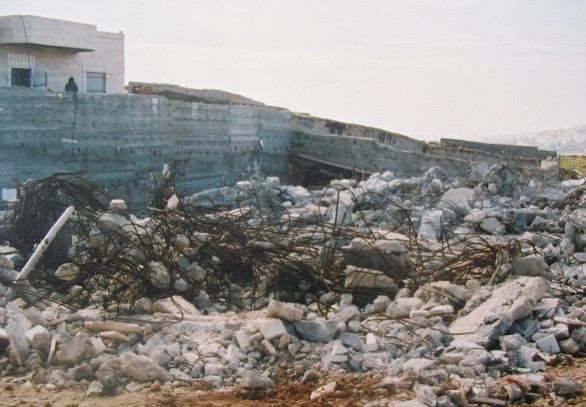
Photo 2: Shu'fat- Al Ashqariya quarter- Jerusalem: the ruins of the house of Mr. Imam ash
Shuweiki after demolition under the pretext of un- licensing.
Photo courtesy of LRC
-
A six-story building owned by Mr. Isam Mustafa Harhash in Ashayyah Neighborhood in the village of At-Tor ( Mt. Olives). The building (area = 1400 m2) consisted of 10 housing units in addition to 6 stores. According to Mr. Harhash, he wanted to turn the building into a house for the elderly, a service which the city is severely lacking. The building was destroyed on February 22nd. See Photo 3
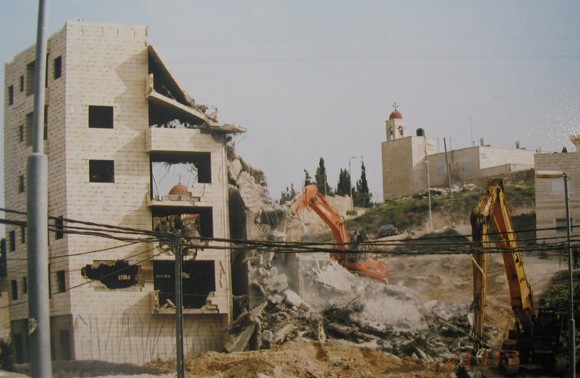
Photo 3: Mt. Olives (Attur quarter) – Jerusalem: Israeli destructive machinery polling down
the building of Mr. Isam Harhash under the pretext of un- licensing.
Photo courtesy of LRC
-
The building of Mr. Muhammad Jameel Salameh Al Atrash in Mintar Neighborhood at Sur Baher. The building which was destroyed on 23.2.05 consisted of 3 housing units with a total surface area of 180 m2. Note here that this building is one of seventy three other buildings threatened to be demolished by the Jerusalem Municipality under the pretext of building without a permit.
-
Mr. Faâ??iq Nasif Habash, a resident of the Old Cityâ??s Islamic Higher Council Street, was forced to add a 14-m2 room to his house in which 8 individuals (including 4 children) live. The Municipality's Court ruled in 1996 to demolish the addition as well as to fine Habash NIS 3,000. In February 2004, the Court fined him an additional NIS 10,000 and ordered him to demolish the additional room within a year otherwise he would face a three-month jail sentence. On February 28th, 2005, Habash demolished his own building himself.
-
The building of Mr. Mohammed Ahmad Ja'abis from Asala'a â??Jabel Al Mikaber, was destroyed on December 12, 2005, under the pretext of un-licensing. The building had a total surface area of 640 M2 and comprised of three flats and tow c9ommercila stores. It belonged to four handicapped brothers and their 15 family members, including 5 children.During the demolition process one of the four handicapped brothers became under physical attack at the hands of the Israeli soldiers.
-
Demolishing two adjacent houses in Ashqariya quarter, Beit Hanina: the first is owned by Mr. Mazen AbdulAzim Abu Subeih (110 M2) and, the second is owned by Mr. Mohammed Bader Ash Shuweiki (120 M2). The two houses have been inhabited since 15 months at the end of which the occupants found themselves homeless in streets, including a 17 day old baby. Most of the furniture was destroyed or scattered in the vicinity of the demolished houses.
-
Damaging a mobile house (caravan) inhabited by the family of Ayman Ahmad Al Batsh in Tel Aful area in Beit Hanina. The Caravan is 40 M2 and was inhabited by a four family members including two children. The owner was obliged to buy the caravan and move to this area after the demolition of his house in the village of Bir Nabala in 2004 under the pretext of un-licensing.
A Temporary Halt in Executing Demolishing:
The Jewish Municipality of occupied Jerusalem was prevented from demolishing four houses in Beit Hanina on February 8th, 2005 as the owners of the houses managed to get court rulings to postpone the demolishing process. The houses are owned by:
1. Ramadan Bader and Suleiman Taim from Al Sharqiya neighborhood in Beit Hanina.
2. Noor ad Dimairy from Tal Al Fool neighborhood in the eastern part of Beit Hanina. His house was previously demolished in 2003.
3. Kameel Al Saâ??ou whose demolition order against his house haslost validity because of the expiry of demolition order.
4. Adnan ash Shuweiki who rented the house out to the families of Yousef Zeghayer and Abdulla Muhtaseb. On the day of the attempted demolition Municipality employees, accompanied by the Israeli Police and the Border Police, evicted the two families and threw all of their belongings and furniture into the streets. Yet, the owner managed to get a temporary halt of the demolishing after paying a fine of NIS 8,000. Such a fine is reimbursable if the demolishing order is revoked. Otherwise, Shuweiki stands to both lose the fine and the two houses. See Photo 4
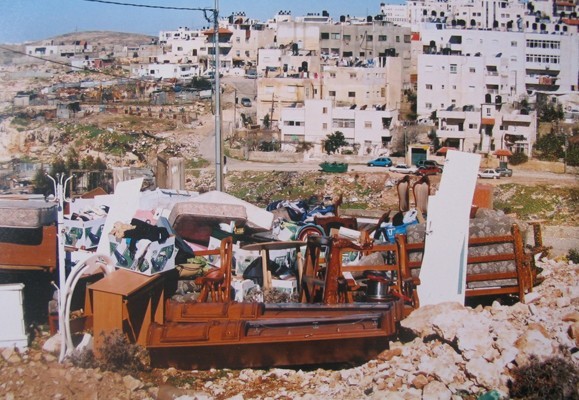
Photo 4: Shu'fat- Al Ashqariya quarter- Jerusalem: Furniture belonging to
the families of Zeghayer& Muhtaseb thrown out of the two houses.
Photo courtesy of LRC .
Stringent and Illegal Procedures
For the first time ever a judge in the Israeli Central Court ruled in a court session held on February 17th, 2005 that the conditions set by the Municipality for building permits for Palestinians are both â??stringent and illegal.â?? As such, the judge ordered both the lawyers of the residents and the Municipality to agree on simpler and doable procedures that can be implemented. These procedures are set to be submitted to the court on the 1st of May, 2005.
New Demolition Orders:
The Jerusalem Municipality has recently submitted tens of demolition orders to Palestinians in a number of locations in East Jerusalem under the pretext of building without permits. Demolition in Sur Baher is due to the Israeli intention of creating a security buffer zone for the Israeli Apartheid Segregation Wall set to pass near the village.
An Unexecuted Court Order:
The Israeli Central Court in Jerusalem issued a ruling allowing the return to Mrs. Azhariya Al Zughayer to her house which was occupied by Jewish settlers on September 14th, 2004. The house is located in Housh Al Zawaya in Al Wad Neighborhood in the Old City. Up to this date the ruling is not executed due to the pretext that the key to the house is kept at the Israeli police headquarter.
Silwan house demolition notifications – Another War crime
The Palestinian residents of the village of Silwan, Jerusalem, especially in Al Bustan Neighborhood, live a life of worry and irritation due to the decision of the Municipality of occupied Jerusalem and its Neighborhood Plan number E/M/9. Such a Plan was designed by the Municipality's Engineer at the beginning of the seventies of last century and called for the demolition of more than 100 Palestinian houses in which more than 140 families live. Most of these houses, whose total population mounts to more than 1000, were established before the occupation of the West Bank in 1967 and even before the establishment of the State of Israel in 1948 while some of these houses were built 10 to 15 years ago. Israeli authorities have based its decision on claims and ploys from which the repulsive smell of racism is emitted. See Map 1
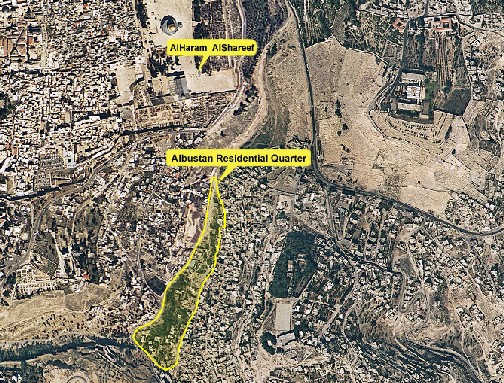
See Map 1: an aerial photo for Al Bustan quarter- Silwan
According to the afore-mentioned Israeli Neighborhood Plan, the exact term that was used to describe the targeted area was the Holy Parcel whose establishment requires the uprooting of the Gwuiem (strangers) and to replace them by The Sons of the Forefathers with the aim of making the whole city of Jerusalem look like how the Forefathers envisioned it 3,000 years ago. The designer of the Plan shamelessly expressed such racism at the beginning of the seventies when he refused to grant permissions to build schools, playgrounds and other services in Al Bustan Neighborhood. He indicated then that 'We are looking for the situation as it was in the year 90 BC.'
Effects and Goals of the Racist Neighborhood Plan Number E/M/9:
At a time when tunnel building beneath the Al Haram Al Sharif compound is being conducted and when the construction work is continuing in the Jewish colony of Maâ??ale Zitim in Ras Al Amoud while taking over Palestinian holdings in the area of Wadi Hilwa in Silwan, this new plan aims to create a geographical continuity between the above-mentioned locations and some parts of Western Jerusalem via Moroccan Quarter inside the old city and the nearby Zion Mountain. Moreover, this particular plan aims at the following:
-
Creating a suitable environment to attack andor destroy the Al Haram Al Sharif as a prelude to the establishment of the Third Temple.
-
Reducing to a minimum the Palestinian presence in the above-mentioned locations which are considered to be the cityâ??s western gate.
-
This plan is considered to be the largest Palestinian population transfer in Jerusalem since the occupation of the city in 1967.
-
Tricking the Palestinian population of Al Bustan as Israeli authorities gave out demolition orders for 30 â?? 40 houses while promising its inhabitants to find â??alternative governmental landsâ?? as a substitute for their lands. Despite this fact, the Municipality has clearly stated that it will demolish the houses even if an alternative housing was not found.
-
The intention of demolishing old houses though Israeli law protects it. The Municipality is using Article 212/5 of the 1965 Building Code to facilitate the demolition as this article was used in the demolition of ten ancient houses in Al Bustan Neighborhood in the past ten months. See Photo 5.
Photo 5: a digital photo showing the targeted houses of Silwan
Photo courtesy of LRCPhoto courtesy of
Israeli Phony Claims:
The claim of the Municipality of occupied Jerusalem that it targets only â??illegalâ?? houses is a baseless claim especially given the fact that there are other areas in Jerusalem that has a larger density of â??illegalâ?? houses than that of Al Bustan Neighborhood. Amiraf, an ex-member of the Municipality of occupied Jerusalem, stated regarding the issue that â??the Jordanian government has approved in the past the Master Plan for Al Bustan Neighborhood, yet Israel torpedoed its implementation. International pressure compelled Teddy Kollek, former head of the Municipality of occupied Jerusalem to declare that the Municipality would finish the Master Plan in a two-year period, which he didnâ??t.
Silwan Residents Refuse the Israeli Decision of House Demolition:
Mr. Musa Oudeh (47 years old) indicated in an interview with LRCâ??s field worker that: 'I was born here. Got married here. My kids were born and raised here. I lived, and will continue to live here. The conspiracy against Al Bustan is only a part of the bigger scheme to Judiaze the Holy City of Jerusalem.'
Mr. Salah Abu Shafeâ?? (40 years old), a father of 8, expressed the following: ' I built a house on my land and the Municipality demolished it 11 years ago under the pretext of building without a permit. We had no other choice but to build it again on the same land 6 years ago. The first and second building processes in addition to the fines imposed upon us have reached about NIS 1.0 million'.
House demolition versus house construction
The announcement by Sharon's government during 2005 of the approval of the plan for constructing a Jewish colonial nucleus to be consisted of 21 housing units and a synagogue in Burg Al Laqlaq of the old city of Jerusalem comes as part of the displacement and replacement policy currently being implemented by the Israeli right wing extremist government in occupied Jerusalem.
The plan for building this colony dates back to 1990 when, first, Ariel Sharon, the then minister of housing, disclosed it amidst celebrations on the 31st anniversary of the Israeli occupation and annexation of Jerusalem. According to Sharon's plan, 200 housing units were planned to be built at the site. See Map 2
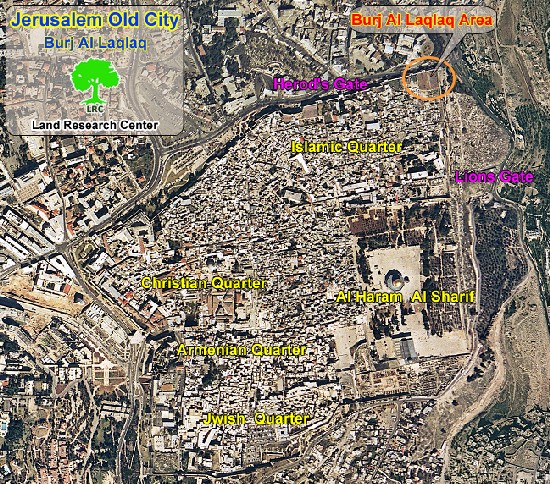
Map 2: location of Burj Al Laqlaq
Second, at the time of Benjamin Netniyaho's government, another plan was ratified according to which a religious school, two residential buildings, six floors each, including parking lots and two underground tunnels were planned to be introduced to the site.
Following this, on May 24th, 1998, a group of colonists from the colonial organization ' Atarit Cohanim' under the protection of the Israeli army laid the corner stone for this colony at ten PM in the place called the ' Land of Maskub' whose total area is 2200 square meters belonging to the Russian Church in the holy land. Atarit Cohanim claimed that it had bought it from the colonial Himonita Company affiliated to the Kern Ki'imet (Israeli National Fund) which bought it from the White Russian Church in the year 1982 in a secret deal. According to this deal, the Israeli ministry of Agriculture exported citrus to the republic of white Russia at the cost of 2 Million US $ in change for the transfer of the land ownership to the Israeli ministry of agriculture.
On the following night, Israeli colonists brought caravans (mobile homes) to the scene and settled in them.
Burg Al Laqlaq area is located in the north eastern corner of the old city of Jerusalem. It is part of the densely populated Islamic quarter. The total area of Burg Laqlaq is 11 dunums ( 11000 M2) , Located between Bab Al- Asbat (Lions Gate) in the eastern part of the wall and Bab Al- Zahera ( Herod's Gate) in the northern part of the wall. The area over looks the Haram Al- Sharif compound to the south, Rockfler museum to the north and Mount of Olives and Mount Scopus to the east and north east.
Israeli plans
Following the laying down of the corner stone for the Jewish colony in Burg Al Laqlaq on May 24, 1998, anger broke out in the old city leading to confrontations between the Palestinian citizens, on one side, and the Jewish colonists and the army, one the other side, at the end of which the building process was halted on June 12, 1998 as a part of a deal reached between the Israeli government and Atarit Cohanim according to which excavation and digging works were allowed at the site. A security observation post was also allowed as part of this deal which was introduced next to the Wall in Bab Huta leading to Burj Al Laqlaq. After wards, the Israeli ministries of Infrastructure and Antiquities started a wide scale excavation campaign at the site. See Photo 6
Photo 6: an Israeli security observation pint in Bab Huta
on the way to Burj Al Laqlaq, Photo courtesy of LRC.
This excavation campaign was led by the former minister of Tourism Bani Iyalon who is considered the chief supporter of Jewish extremist colonization organizations headed by Atarit Kohanim which persistently tries to get foot holds in every corner of the old city. So far, its members managed to seize dozens of homes and properties in 60 nuclei in the Muslim, Christian and Armenian quarters of the old city. See Photo 7
Photo 7: An Israeli large crane taking part in the excavation
campaign in Burj Al Laqlaq – Photo courtesy of LRC.
The excavation campaign was just a preliminary step towards the final ratification of the establishment of at least 21 housing units for exclusive Jewish use in Burg Al Laqlaq area as mentioned above.
The plan aims at controlling this sensitive area and the two most important gates of the old city, Bab Al -Asbat (Lions Gate) and Bab Alzahera ( Herod's Gate).
This Israeli project is considered, in particular, an Israeli penetration of the Islamic quarter which is relatively free of colonization nuclei. It is, also, sensitive in two ways: firstly, in strengthening security in the old city and, secondly, in bringing more colonists into the old city which, consequently, will create a demographic change for the benefit of Israeli colonists.
In case this project was completed, it will form the second largest colonialist block in the old city after Maghareba (Moroccan) quarter uta for the benefit of Hu(Jewish quarter).
Waqf land
The Islamic Awqaf (Endowment affairs) authorities in Jerusalem confirmed that the Burg Al Laqlaq land is totally Waqf land (Islamic trust) and contains Islamic and Byzantine antiquities. The Israeli government prevents Palestinians from building, renovating or extending already existing houses in the area under the pretext that the land is an archeological site. In the meanwhile, The Israeli authorities destroyed large areas of archeological importance to make room for the construction of Jewish quarters as had happened in Maghareba (Moroccan) quarter of the old city.
A provocative project
The Israeli Yarushalaim newspaper, on its edition of May 27th, 2005, mentioned that this project which was prepared by the ministry of housing and construction will consist of a luxurious synagogue covered by a golden dome to compete with the prestigious Islamic Dome of the Rock.
Although the project represents a violation of all the principles of planning and construction inside the Walls of the old city it was approved by the municipality of occupied Jerusalem and by Israeli government. See Photo 8.
Photo 8: The house of the family of Abu Ghazaleh destroyed by
Israelis on 7.2.1999 during excavation works and left with no repair.Photo courtesy of LRC
Photo courtesy of LRC
The project was described by the Member of the municipality council, Papa Alanu, as being impractical and provocative which will initiate a third Intifada. From the organizational and planning point of view it constitutes a disaster as it contradicts all the principles of maintaining and preserving the old city and its urban master planning.
On the other hand, Knesset member, Ran Cohen, forwarded a message to Ishzaq Cohen in which he said the following: 'The essence of this plan is to get a political foot hold inside the old city. It is a barrel of explosives which might light the city and tear the already sensitive and tense relationships between Muslim and Jews of the Old city'.
Building Restrictions and Eviction continued
Master Plan means, In general terms, the organization of the land (location, neighborhood, city) vis-� -vis its population, buildings, establishments, services, land usage, streets and the basic infrastructure. The Master Plan is usually science-based and takes into consideration the future needs of the population for the upcoming 15 to 20 years, especially, in terms of population growth and its housing needs.
Given that the Israeli goal is to get rid of the Palestinian population through eviction, the best tool to achieve such a goal was to stop Palestinian building. As such, delaying the issuance of the Master Plans was a consistent Israeli policy. Palestinian homes built during the delaying period are expected to be demolished under the pretext that it was built without the â??proper licenses.â?? Seventeen years have passed without placing the approval seal of the Jerusalem Municipality on any Master Plan in East Jerusalem. Today (38 years after the beginning of the Israeli occupation) some of the regions in East Jerusalem are still without any Master Plans while those areas that have Master Plans did not take into consideration the needs of the population in a number of areas including:
-
Land usage.
-
The increasing gap between the natural growth of the population and the amount of land available for them to be used for population expansion.
-
The private and Green areas.
-
The obstacles placed on house development.
Isawiya village faces a continuous Demolition Campaign
The location of the village of Isawiya at the top of the French Hill has made it a prime target for occupation forces and authorities. As such, its lands were expropriated left and right in an attempt to veto and hamper any possible Palestinian population expansion, to allow further future expansion of the French Hill and Givat Shapira, not to hamper the implementation of the Eastern Ring Road, not to act like a buffer zone between the colonies of Maâ??ale Adumim and the French Hill in addition to not being a natural barrier for the expansion of the nearby Israeli military camp, the Hebrew University or the Hadasa Hospital. See Photo 9
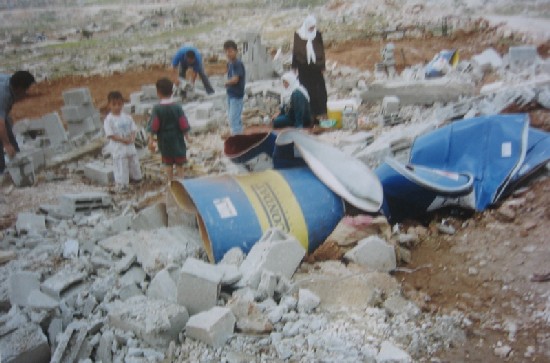
Photo 9: the ruins of the family house of Mr. Omer
Mohammed Dari – Photo courtesy of LRC
Following that reasoning, it was only natural that Palestinian homes in Isawiya became targets for Israeli demolishing under a number of pretexts such as what took place on January 26th, 1999 when Israeli soldiers shot dead Mr. Zaki Noor Al Dien Obied (22 years old) and injured 12 others while trying to demolish the house of Mr. Mahmoud Issa Abu Oweis. The following statistics give a glimpse and an indication of the fierce campaign waged by Israel on Palestinian building in the village of Al Isawiya:
|
No. of demolished housing units |
Duration |
|
27 |
From 01.01.1985- 31.12.1999 |
|
8 housing units + 19 tens + 6 barracks |
1.1.2000-31.12..2000 |
|
15 |
1.1.2002-31.12.2002 |
|
13 |
1.1.2003-31.12.2003 |
|
2 |
1.1.2004-31.12.2004 |
|
5 |
1.1.2005-31.15.2005 |
|
Total |
70 permanent housing units + 19 tents + 6 barracks |
Photo 12: In the foreground a destroyed Palestinian house in the lands of Isawiya,
in the background a hill top occupied by Israel and leveled for permanent construction
Photo courtesy of LRC
Table No. (2): Demolition, closure and seizure of Palestinian houses and
structures by year under the pretext of un-licensing and security – Jerusalem governorate
|
Year |
House demolition |
Barrack & store demolition |
Tent demolition |
House closure |
House seizure |
Eviction under the pretext of being old |
Total |
No. of affected people |
|
|
|
|
|
|
|
|
|
|
Fam. mem |
Child. |
|
1997 |
27 |
56 |
58 |
— |
4 |
0 |
145 |
NA |
NA |
|
1998 |
31 |
— |
— |
1 |
1 |
0 |
33 |
NA |
NA |
|
1999 |
39 |
— |
17 |
3 |
5 |
0 |
64 |
NA |
NA |
|
2000 |
33 |
1 |
45 |
3 |
1 |
0 |
83 |
200 |
120 |
|
2001 |
78 |
9 |
— |
2 |
1 |
0 |
90 |
500 |
270 |
|
2002 |
78 |
12 |
— |
10 |
— |
0 |
98 |
509 |
273 |
|
2003 |
147 |
10 |
0 |
1 |
9 |
11 |
178 |
996 |
553 |
|
2004 |
175 |
50 |
0 |
1 |
34 |
0 |
260 |
631 |
350 |
|
2005 |
120 |
25 |
0 |
0 |
0 |
0 |
145 |
481 |
249 |
|
Total |
728 |
163 |
120 |
21 |
55 |
11 |
1096 |
3317 |
1815 |
Source: LRC field work
Prepared by
The Land Research Center
LRC


